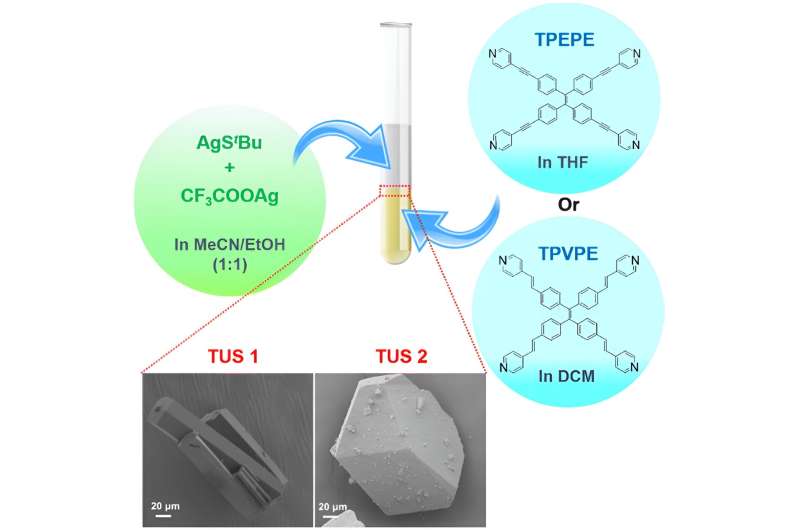This article has been reviewed according to Science X's editorial process and policies. Editors have highlighted the following attributes while ensuring the content's credibility:
fact-checked
peer-reviewed publication
trusted source
proofread
Towards silver cluster-assembled materials for environmental monitoring

In recent years, there has been a growing interest in using silver nanoclusters (Ag NCs), nanoscale silver particles composed of tens to hundreds of atoms, across various fields like material science, chemistry, and biology. Ag NCs typically have sizes ranging from 1–3 nm. Scientists have made significant progress in creating and manipulating Ag NCs, leading to the development of silver cluster-assembled materials (SCAMs).
SCAMs are light-emitting materials made up of many interconnected Ag NCs, joined together by special organic linker molecules called "ligands." What is special about them is their molecular-level structural designability and unique photophysical properties. However, their widespread use has been limited owing to their dissimilar structural architecture when immersed in different solvents.
To address this problem, a team of researchers from Tokyo University of Science (TUS), led by Professor Yuichi Negishi and including Assistant Professor Saikat Das, recently developed two new (4.6)-connected three-dimensional luminescent SCAMs comprising an Ag12 cluster core connected by quadridentate pyridine linkers—[Ag12(StBu)6(CF3COO)6(TPEPE)6]n, denoted as TUS 1 and [Ag12(StBu)6(CF3COO)6(TPVPE)6]n, denoted as TUS 2.
"We have successfully developed two silver –cluster-connected architectures with a new linkage structure, which can be applied to environmental monitoring and assessment," explains Prof. Negishi. This study was published in the journal Nanoscale.
The researchers synthesized the SCAMs using the same facile reaction method with the only difference being the linker molecules. They combined [AgStBu]n and CF3COOAg in a solution of acetonitrile and ethanol. The linker molecules TPEPE = 1,1,2,2-tetrakis(4-(pyridin-4-ylethynyl)phenyl)ethene and TPVPE = 1,1,2,2-tetrakis(4-((E)-2-(pyridin-4yl)vinyl)phenyl)ethene were dissolved in separate chemicals, namely tetrahydrofuran and dichloromethane, respectively.
The metal solution was then added to the linker molecule solution and left to crystallize in the dark. After one day, yellow crystals formed near the junction of the two solutions, signifying the creation of the SCAMs.
The team conducted various tests to examine the structure of the SCAMs. They found that TUS 1 had a rod-shaped structure, while TUS 2 had a block-shaped structure. They also tested the chemical stability of the materials by immersing them in different solvents, and found that their crystal structure remained unchanged, highlighting their exceptional stability.
Additionally, due to their exceptional fluorescence properties with a quantum yield of up to 9.7% and stability in water, the team investigated the potential of SCAMs for detecting metal ions in aqueous solutions.
To their delight, both SCAMs were highly sensitive to Fe3+ ions, which effectively quenched their fluorescence at room temperature, indicating the presence of Fe3+ ions. The detection limits of Fe3+ ions were 0.05 and 0.86 nM L–1 for TUS 1 and TUS 2, respectively, comparable to the standard values. Furthermore, both SCAMs were highly selective towards Fe3+ and were not affected by other common metal ions.
These results suggest a potential application of SCAMs in environmental monitoring, particularly in detecting Fe3+ ions in water. "The ability to link silver clusters via various linkage modes can enable a bottom-up fabrication of materials with various physicochemical properties. Further developments nanotechnology can thus allow us to fabricate materials and devices on a smaller scale, which is expected to lead to higher functionalities in materials and devices," says Prof. Negishi.
More information: Jin Sakai et al, Synthesis and luminescence properties of two silver cluster-assembled materials for selective Fe3+ sensing, Nanoscale (2023). DOI: 10.1039/D3NR01920A
Journal information: Nanoscale
Provided by Tokyo University of Science





















